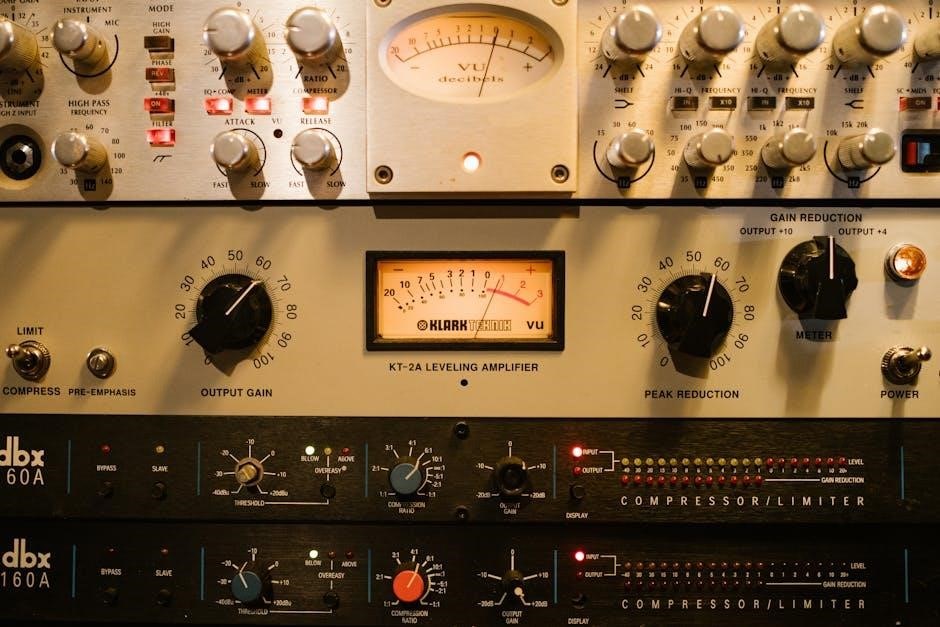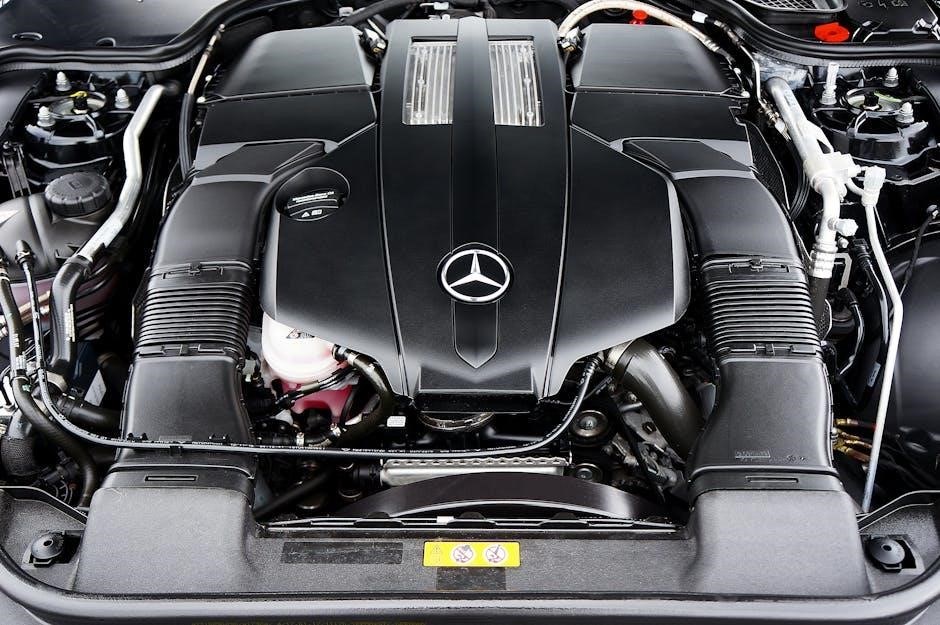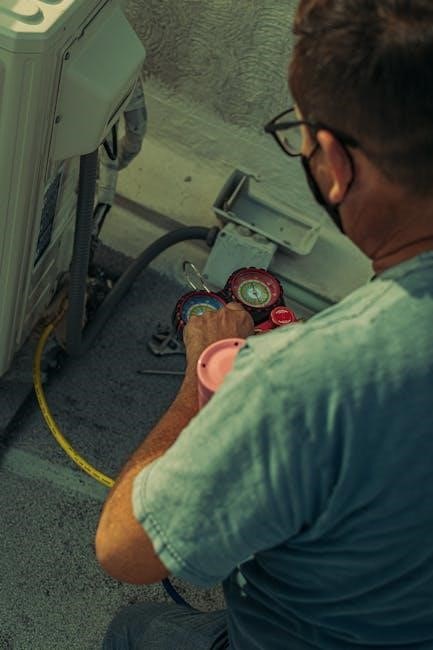ingersoll-rand compressor fault codes pdf
Understanding Ingersoll-Rand compressor fault codes is crucial for efficient maintenance and troubleshooting. This section explains how to identify and resolve common issues using these codes effectively.
Overview of Ingersoll-Rand Compressors and Their Importance
Ingersoll-Rand compressors are widely recognized for their reliability and efficiency in industrial and manufacturing applications. They provide consistent air pressure, ensuring smooth operations across various industries. These compressors are designed to meet high-performance demands while maintaining energy efficiency. Understanding their fault codes is essential for proactive maintenance, minimizing downtime, and extending equipment lifespan. Regular troubleshooting using these codes helps diagnose issues early, preventing costly repairs and ensuring optimal productivity.
Why Understanding Fault Codes is Crucial for Maintenance
Understanding fault codes is vital for maintaining Ingersoll-Rand compressors. These codes provide clear indicators of specific issues, enabling quick diagnosis and repair. By interpreting codes, technicians can address problems before they escalate, reducing downtime and extending equipment life. Regular monitoring and code analysis ensure optimal performance, prevent unexpected failures, and lower maintenance costs. This proactive approach is essential for industries relying on compressed air systems for continuous operation.
Common Ingersoll-Rand Compressor Fault Codes
Common Ingersoll-Rand compressor fault codes include 9 (air filter restriction), 1 (high discharge temperature), and 6309 (engine preheat failure). These codes help diagnose and resolve issues efficiently.
Fault Code 9: Air Filter Restriction Switch
Fault Code 9 indicates an issue with the air filter restriction switch. The SECU controller detects a closed switch, signaling a potential blockage. This is an alert, not a shutdown, but it requires attention. A restricted air filter can reduce compressor efficiency and lead to overheating or poor performance. Cleaning or replacing the air filter typically resolves this issue. Always refer to the manual for specific guidance on resetting the code after addressing the problem to ensure proper system function.
Fault Code 1: S3 Discharge Temperature High
Fault Code 1 signifies a high discharge temperature at stage S3, which can lead to compressor damage if unaddressed. Causes include dirty air filters, malfunctioning cooling systems, or sensor issues. The SECU controller monitors these temperatures and triggers this alert to prevent overheating; Cleaning or replacing the air filter and ensuring proper coolant flow are common solutions. If the issue persists, inspect the temperature sensor or consult a professional. Addressing this promptly ensures optimal compressor performance and prevents potential shutdowns or further damage.
Fault Code 6309: Engine Preheat Failure
Fault Code 6309 indicates an engine preheat failure, which occurs when the preheat function does not activate properly. This is crucial for cold-weather starts, as it ensures proper engine lubrication and prevents damage. Common causes include a faulty preheat switch, wiring issues, or connector problems. To resolve this, test the preheat switch, inspect wiring for damage, and ensure all connections are secure. Addressing this promptly prevents engine damage and ensures reliable compressor operation during cold conditions.

Diagnosing Compressor Issues Using Fault Codes
Fault codes provide essential insights for diagnosing compressor issues, enabling quick identification of problems like air filter restrictions or engine preheat failures through the SECU controller and LED displays.
Using the SECU Controller for Fault Detection
The SECU (Smart Electronic Control Unit) is a critical component for detecting and interpreting fault codes in Ingersoll-Rand compressors. It monitors various system parameters, including air filter restriction, discharge temperature, and engine preheat status. When a fault occurs, the SECU logs the specific code and illuminates the LED display, providing clear indicators for troubleshooting. For instance, Fault Code 9 indicates an issue with the air filter restriction switch, while Fault Code 6309 points to an engine preheat failure. By referencing the SECU’s error messages, technicians can quickly identify and address compressor issues, minimizing downtime and ensuring optimal performance.
Interpreting LED Displays and Error Messages
Ingersoll-Rand compressors utilize LED displays to communicate fault codes and error messages, ensuring quick issue identification. The LEDs flash in specific patterns to indicate different fault categories, such as electrical or mechanical issues. For example, a steady red light may signal a critical error, while a flashing yellow light indicates a warning. Error messages, often displayed as numerical codes like Fault Code 9 (air filter restriction) or Fault Code 6309 (engine preheat failure), provide detailed insights into system malfunctions; Referencing the official PDF manuals ensures accurate interpretation and effective troubleshooting.

Troubleshooting Steps for Common Faults
Begin by checking the LED display for specific error codes, such as Fault Code 9 or Fault Code 6309. Refer to the PDF manual for code meanings and solutions.
Systematic Approach to Identifying the Root Cause
A systematic approach involves reviewing the fault code history, inspecting components, and testing suspected issues. Start by checking the LED display for specific error codes, such as Fault Code 9 or Fault Code 6309. Refer to the PDF manual for detailed explanations and recommended solutions. Next, verify system parameters like oil levels, air filter condition, and coolant temperature. Use diagnostic tools to isolate the problem, ensuring repairs are precise and effective. This method minimizes downtime and prevents recurring issues.
Resetting Fault Codes After Repair
After resolving the issue, reset the fault codes using the SECU controller. Access the service codes menu, select the “Clear Fault Codes” option, and confirm. Ensure the compressor is turned off and allowed to cool before resetting. If the issue persists, refer to the PDF manual for specific reset procedures. Always verify system operation after clearing codes to confirm the repair was successful. Proper reset ensures accurate monitoring and prevents false alarms, maintaining compressor efficiency and reliability.

Preventive Maintenance to Avoid Common Faults
Regular air filter cleaning, oil level checks, and sensor inspections are vital. Schedule routine servicing and monitor system performance to prevent faults and ensure optimal operation.
Regular Air Filter Cleaning and Replacement
Regular air filter cleaning and replacement are essential for preventing compressor faults. A dirty air filter can trigger fault codes like Code 9, indicating restriction. Clean or replace filters as recommended in the manual to ensure proper airflow and system efficiency. Use genuine Ingersoll-Rand parts to maintain performance. Schedule routine inspections to avoid pressure issues and sensor malfunctions. Proper filter maintenance reduces downtime and extends compressor lifespan, ensuring reliable operation and minimizing repair costs over time.
Monitoring Oil Levels and Quality
Monitoring oil levels and quality is vital for preventing compressor faults. Low oil levels can trigger alerts, while contaminated oil may cause mechanical failures. Check oil levels daily and top up as needed using Ingersoll-Rand-approved oil. Regular oil analysis detects contaminants and wear metals, ensuring optimal performance. Replace oil filters every 500-1,000 hours to maintain system health. Proper oil management prevents engine and compressor faults, reducing downtime and extending equipment lifespan. Always refer to the manual for specific oil recommendations and maintenance schedules to ensure reliability and efficiency in your compressor operations. Regular oil changes are essential for maintaining peak performance and preventing costly repairs. Contaminated oil can lead to premature wear on moving parts, so it’s crucial to use high-quality filters and oil. By prioritizing oil care, you minimize the risk of fault codes related to lubrication issues, ensuring smooth and efficient compressor operation.

Accessing Ingersoll-Rand Compressor Manuals and PDFs
Access official Ingersoll-Rand compressor manuals and PDFs through the Compressor Systems CAGI Data Sheet Library. Troubleshooting guides and service manuals are also available on third-party sites.
Official Sources for Downloading Manuals
The Compressor Systems CAGI Data Sheet Library provides official Ingersoll-Rand manuals and PDFs. Users can preview, download, save, or print documents, including owner’s manuals, CAD drawings, and product specifications. This resource ensures access to authentic and up-to-date information for troubleshooting and maintenance. Additionally, Ingersoll-Rand’s official website offers dedicated sections for service codes, fault diagnostics, and repair guidelines, making it a reliable source for all compressor-related documentation needs. This centralized access simplifies maintenance and repair processes.
Third-Party Websites for Troubleshooting Guides
Third-party websites like Scribd and PDF sharing platforms offer downloadable guides for Ingersoll-Rand compressor fault codes. These resources often include troubleshooting steps, diagrams, and detailed explanations for common issues. For example, documents on Scribd provide lists of fault codes such as Code 9 (air filter restriction) and Code 1 (high discharge temperature), along with repair solutions. Additionally, forums and independent repair websites share user experiences and fixes, offering practical insights for resolving compressor faults efficiently. Always verify the reliability of third-party sources.

Understanding Compressor Fault Code Categories
Fault codes are categorized into electrical, mechanical, and temperature-related issues. Each category provides specific insights, enabling targeted troubleshooting and efficient resolution of compressor problems.
Electrical Faults vs. Mechanical Failures
Electrical faults in Ingersoll-Rand compressors often involve issues like blown fuses or sensor malfunctions, while mechanical failures may stem from worn parts or lubrication problems. Understanding the distinction is key to effective troubleshooting. Electrical faults typically manifest as error codes related to circuit failures or sensor inaccuracies, whereas mechanical issues might show as pressure drops or abnormal vibrations. Addressing these categories separately ensures targeted repairs, minimizing downtime and extending equipment life. Regular maintenance can help prevent both types of failures, ensuring optimal compressor performance.
Temperature-Related Fault Codes
Temperature-related fault codes in Ingersoll-Rand compressors indicate issues with overheating or abnormal thermal conditions. Codes like Fault Code 1 (S3 Discharge Temperature High) highlight excessive heat in critical components. These codes often result from clogged air filters, cooling system malfunctions, or sensor inaccuracies. Addressing these issues promptly is vital to prevent damage and ensure efficient operation. Regular maintenance, such as cleaning air filters and inspecting cooling systems, can help mitigate temperature-related faults. The SECU controller monitors these conditions, providing essential alerts for timely intervention. Always refer to the manual for specific diagnostic steps.

Specific Fault Codes for Ingersoll-Rand Nirvana Series
Fault Code 24291 indicates service code alerts, while Nirvana VSD fault codes signal variable-speed drive issues. These codes provide insights into compressor performance and require manual consultation for resolution.
Fault Code 24291: Service Code Alerts
Fault Code 24291 triggers service code alerts on Ingersoll-Rand Nirvana series compressors, indicating maintenance or component issues. This code, displayed via the SECU controller, signals potential problems such as air filter restriction or sensor malfunctions. While it doesn’t shut down the compressor, addressing the issue promptly is essential to prevent further complications. Refer to the troubleshooting manual for specific solutions and ensure proper calibration of sensors to resolve the alert effectively and maintain optimal compressor performance.
Nirvana VSD Fault Codes and Their Implications
Nirvana VSD fault codes provide critical insights into compressor performance and potential issues. These codes, displayed via the SECU controller, help identify problems such as temperature fluctuations, pressure imbalances, or sensor malfunctions. Addressing these codes promptly is essential to prevent downtime and ensure optimal operation. Regular maintenance, such as air filter cleaning and sensor calibration, can help mitigate issues. Consulting the troubleshooting manual for specific solutions is recommended to resolve faults efficiently and maintain the compressor’s reliability and productivity.

Engine and Compressor Fault Code Differences
Engine fault codes often relate to oil pressure or coolant levels, while compressor codes focus on pressure issues or discharge temperatures. Each category requires specific troubleshooting approaches.
Engine Oil Pressure and Coolant Level Alerts
Engine oil pressure and coolant level alerts are critical for maintaining optimal performance. Fault codes like 2010 (coolant temperature alarm) and 2020 (oil pressure alarm) indicate potential issues. These systems monitor vital parameters to prevent engine damage. Addressing these alerts promptly ensures compressor longevity and reliability, avoiding costly repairs. Always refer to the official manual for specific troubleshooting steps and solutions to resolve these alerts effectively.
Compressor-Specific Codes for Pressure Issues
Compressor-specific fault codes for pressure issues are vital for diagnosing system malfunctions. Codes like 1 (S3 discharge temperature high) or 24291 (system pressure deviation) indicate potential pressure-related problems. These alerts often result from blocked air filters, faulty pressure sensors, or improper valve operation. Addressing these issues promptly ensures optimal performance and prevents damage. Always consult the official manual for detailed troubleshooting steps and solutions to resolve pressure-related faults effectively and maintain compressor efficiency.
Advanced Troubleshooting Techniques
Advanced troubleshooting involves using diagnostic tools like the SECU controller and software for in-depth fault code analysis. This approach ensures precise identification and resolution of complex issues efficiently.
Using Diagnostic Tools for In-Depth Analysis
Diagnostic tools like the SECU controller provide detailed insights into compressor operations, enabling advanced fault code analysis. These tools monitor parameters such as temperature, pressure, and system performance in real-time. By accessing fault codes through the SECU display or related software, technicians can pinpoint issues efficiently. For instance, fault codes like Code 9 (air filter restriction) or Code 1 (high discharge temperature) can be analyzed to identify root causes. Additionally, consulting official Ingersoll-Rand compressor manuals and troubleshooting guides ensures accurate diagnoses and repairs, minimizing downtime and optimizing system performance.
Software Solutions for Fault Code Interpretation
Ingersoll-Rand provides advanced software tools for interpreting fault codes, enabling technicians to perform in-depth analysis. These solutions connect to the SECU controller, offering real-time monitoring and detailed fault code databases. Technicians can access historical data, analyze trends, and troubleshoot issues efficiently. Advanced features include predictive maintenance alerts and customizable reports, enhancing diagnostic accuracy. By leveraging these software solutions, users can streamline fault code interpretation, ensuring faster repairs and minimizing operational downtime.
Common Electrical Issues and Solutions
Common electrical issues include blown fuses, tripped circuit breakers, and sensor malfunctions. Solutions involve checking circuits, replacing fuses, and calibrating sensors to restore functionality and prevent downtime.
Fuse and Circuit Breaker Problems
Fuse and circuit breaker issues are common electrical faults in Ingersoll-Rand compressors. Blown fuses or tripped breakers often result from overloads or short circuits; Check circuits for damage or excessive current. Replace fuses or reset breakers as needed. Ensure proper wiring and load balancing to prevent future occurrences. Regular inspections can help identify potential electrical hazards early. Addressing these issues promptly minimizes downtime and ensures reliable compressor operation. Always refer to the compressor manual for specific troubleshooting steps and safety guidelines.
Sensor Malfunctions and Calibration
Sensor malfunctions are common issues in Ingersoll-Rand compressors, often causing fault codes like high discharge temperatures or engine preheat failures. These sensors monitor critical parameters such as pressure, temperature, and airflow. Calibration is essential for accurate readings. Dirt, misalignment, or electrical issues can disrupt sensor function. Regular cleaning and testing are recommended. If a sensor fails, replace it with a genuine Ingersoll-Rand part. Always refer to the SECU controller or manual for specific recalibration steps. Proper sensor operation ensures reliable compressor performance and prevents costly downtime. Addressing these issues early is crucial for maintaining efficiency and safety.
Oil-Related Faults and Maintenance
Monitoring oil levels and quality is vital for preventing compressor faults. Regular filter replacements and using the correct oil viscosity help maintain efficiency and reduce downtime. Refer to the SECU controller for specific alerts and solutions.
Low Oil Level Warnings and Solutions
Low oil level warnings indicate insufficient lubrication, which can lead to increased wear and potential compressor shutdown. Check the oil level regularly and refill with the recommended viscosity. Ensure the oil filter is clean or replaced if clogged, as this can restrict oil flow. Refer to the SECU controller for specific fault codes related to oil pressure or levels. Addressing these issues promptly prevents damage and maintains optimal compressor performance. Always consult the official manual for detailed guidance on oil-related maintenance.
Oil Filter Clogging and Replacement
A clogged oil filter can restrict oil flow, leading to increased wear and potential engine damage. Regularly inspect and replace the oil filter as specified in the manual. If a fault code indicates oil-related issues, check the filter for blockages. Use genuine Ingersoll-Rand parts to ensure compatibility. Refer to the SECU controller for specific fault codes related to oil pressure or flow. Replace the filter promptly to maintain proper lubrication and prevent compressor downtime. Always follow recommended maintenance schedules to avoid clogging and ensure optimal performance.

Air Filter Restriction and Pressure Issues
Air filter restriction can trigger fault codes like Code 9, indicating a closed switch. Regular cleaning or replacement prevents pressure build-up and ensures proper airflow efficiency.
Causes and Solutions for Air Filter Restriction
Air filter restriction often occurs due to dirt, debris, or moisture buildup. Regular cleaning or replacing the filter can resolve this issue. Ensure proper installation and maintenance to prevent pressure problems. Monitoring airflow and checking for blockages also helps. Addressing these issues promptly avoids system shutdowns and maintains optimal performance. Always refer to the Ingersoll-Rand compressor manual for specific guidance on filter maintenance and troubleshooting.
Pressure Build-Up Problems and Fixes
Pressure build-up issues can stem from blockages, faulty valves, or malfunctioning pressure sensors. Check for obstructions in air lines and ensure valves function correctly. If sensors fail, recalibrate or replace them. Regular maintenance, like inspecting gauges and hoses, helps prevent such problems. Refer to the Ingersoll-Rand troubleshooting guide for detailed steps to diagnose and resolve pressure-related faults, ensuring smooth compressor operation and preventing downtime.

Resources for Further Assistance
Access the Compressor Systems CAGI Data Sheet Library for manuals and guides. Visit Ingersoll-Rand’s official website or contact their customer support for additional troubleshooting resources.
Compressor Systems CAGI Data Sheet Library
The Compressor Systems CAGI Data Sheet Library offers a comprehensive collection of manuals, CAD drawings, and technical documents for Ingersoll-Rand compressors. Users can access product specifications, troubleshooting guides, and warranty information. This resource is ideal for technicians and operators needing detailed instructions or diagrams; The library allows for easy preview, download, and printing of documents, ensuring quick access to critical information. It serves as a one-stop solution for maintaining and repairing Ingersoll-Rand compressors efficiently.
Ingersoll-Rand Customer Support and Forums
Ingersoll-Rand provides extensive customer support, including forums and resources for troubleshooting compressor issues. Users can access official manuals, fault code explanations, and troubleshooting guides. The forums offer a platform to interact with experts and other users, sharing solutions and experiences. Additionally, the support website includes detailed FAQs and contact information for further assistance. These resources ensure that operators and technicians can resolve compressor faults efficiently, minimizing downtime and optimizing performance. Visit the official Ingersoll-Rand website to explore these tools and enhance your maintenance capabilities.
